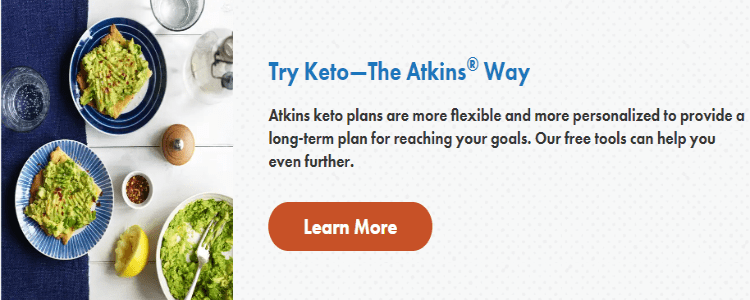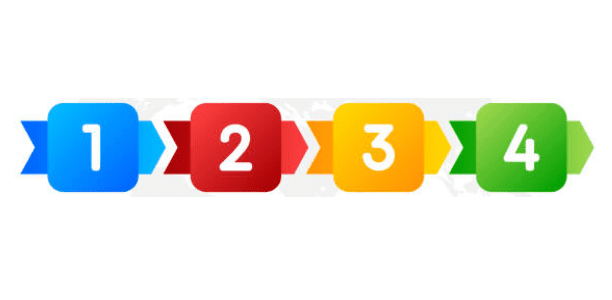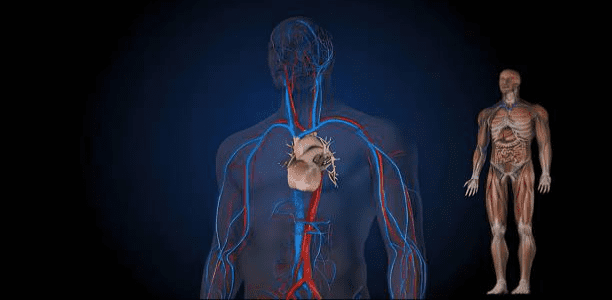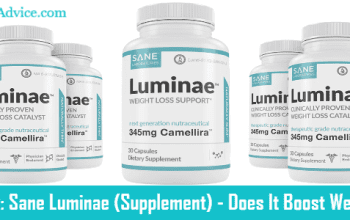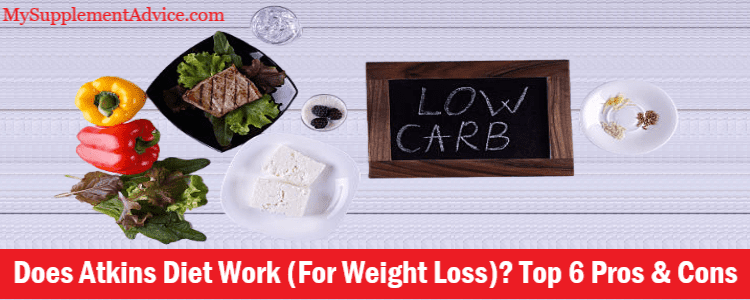
Does the Atkins Diet work for weight loss?
As you probably know, it's a different version of the classic Keto diet.
But is it safe to follow?
Are there any side effects or secondary issues?
Let's take a look at the pros & cons of this diet (and whether it's worth trying out).
Note: This article includes references and studies on Atkins Diet.
Atkins Diet For Weight Loss (In A Nutshell)
Firstly – the Atkins Diet is a low-carbohydrate diet.
Consequently, it encourages the consumption of protein and healthy fats.
It's designed for people who want to shred some weight.
Also, it helps people who want to maintain their desired weight.
In general – this dietary approach comes with 4 phases:
- Induction
- On-going weight loss
- Pre-maintenance
- Maintenance
Basically, each phase will let you control your carbs intake and find the right balance.
Now – the Atkins Diet has 3 plans, depending on a person's weight loss goal and health state:
- Atkins 20®
- Atkins 40®
- Atkins 100™
Again – the plans differ on the number of carbs you can include in your meals per day.
Also, the phases mentioned above might or might not be included in the type of plan.
However – Atkins is a special diet, so there are potential adverse reactions that come with it.
Some of the risks can compromise your physical and mental health.
So if you only want to lose weight, there are some much safer alternatives.
What Is Atkins Diet?
Let's start by mentioning some basic details about the Atkins Diet [1]:
- started by Dr. Robert Atkins
- is a low-carbohydrate diet
- highlights a high intake of proteins and fats
- claims to promote weight loss (and other health benefits)
- also promises to be the best diet for people with carbohydrate intolerance
Now – this diet claims to “flip the body's metabolic switch” to burn more fats.
So this dietary regimen's restrictions revolve around carbs intake.
When you limit carbohydrates and focus on high-protein foods and healthy fats, you reap a lot of benefits.
That's pretty much the approach behind it.
In short – the Atkins Diet is almost identical to Keto Diet, but it offers more flexibility.
With that, let's further discuss how it can support weight loss.
How Can It Promote Weight Loss?
As I mentioned, the Atkins Diet targets excess weight.
In order to reach its goal, it has 4 phases that you need to follow [2]:
- Induction – limiting the number of carbs per day (around 20 grams)
- On-going weight loss – experiment on the level of carbs you can eat daily while losing weight
- Pre-maintenance – building up your carb tolerance or the total carbs you can eat while losing weight
- Maintenance – stick to the total number of carbs you can tolerate daily while losing weight
In addition to the Maintenance phase, you can drop 10-20 grams of carbs if you gain weight again.
In other words, you need to find your carb balance in order to stop gaining more weight.
Again – the Atkins Diet is a version of the Keto Diet.
According to some studies, the ketogenic diet works through ketosis.
This is a process where your body burns fats instead of glucose for energy [3].
So that's how the Atkins Diet kicks weight loss.
However – you don't need to go through each phase (above) during the diet.
Well, the reason is that the Atkins Diet offers 3 plans based on your goals.
So with that, let's take a look at each plan and how it promotes weight loss.
1. Atkins 20®: A Low Carb Ketogenic Diet
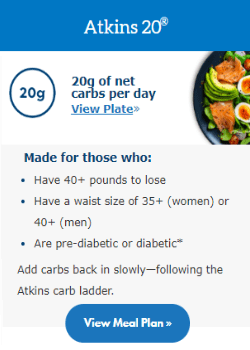
It claims to be suitable for people with the following goals [4]:
- want to lose 40 pounds and more
- are pre-diabetic or diabetic
- women who have 35+ inches waist size
- men with 40+ inches
From the name itself, it promotes a total of 20 grams of carbs only per day.
Also – it strictly implements the 4 phases of the dietary pattern.
However – it has a more specific approach:
- 1st phase – 20 to 25 grams net daily carbs of foundation vegetables, proteins, healthy fats, most cheeses, nuts and seeds
- 2nd phase – 25 to 50 grams net daily carbs with the addition of berries/cherries/melon, whole milk Greek yogurt/ricotta/cottage cheese, legumes and tomato juice
- 3rd phase – 50 to 80 grams net daily carbs with additional fruits, starchy vegetables and whole grains
- 4th phase – 80 to 100 grams net daily carbs of all the foods from the previous phases
So during the first phase, you burn fat via ketosis (just like in any Keto Diet).
The diet states that this process of weight loss can provide greater energy.
At the same time, you're supposed to maintain steady fat-burning metabolism.
This leads to less stored fats, since your body uses up the fats as fuel to function properly.
2. Atkins 40®: The Easy & Effective Low Carb Diet Plan
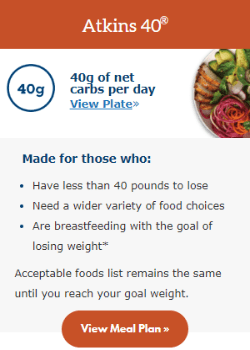
It's made for those people with the following goals [5]:
- have less than 40 pounds to shred
- need more variety of food choices
- pregnant and breastfeeding women who want to lose weight
- people who are pre-diabetic or diabetic
- men with less than 40 inches waist size
- women with less than 35 inches
It's called Atkins 40® because it requires you to start the program with a total of 40 grams of carbs (daily).
So basically, you need to skip Phase 1 and continue straight to Phase 2.
In this diet plan, you can add carbs from foundation vegetables and other carbohydrate-rich foods.
You will then combine them with your regular protein and healthy fat intake.
Also – there's a recommended contribution of a total of 40 grams of carbohydrates:
- 3 x 10 grams for 3 meals per day
- 2 x 5 grams for 2 snacks per day
- you can also do 15 grams per meal and reduce the other servings
- allowed carbohydrate-rich foods are mentioned under Atkins 20®
In addition, you can follow Atkins 20® first until you achieve your desired weight.
After that, you can then shift to Atkins 40® if you want to maintain that weight.
Again – this is a ketogenic approach, so expect to lose weight via ketosis.
But since it has higher net carbs and a more extensive food list, the weight loss might not be so drastic.
3. Atkins 100™: The Easy & Effective 100 Carbs A Day Lifestyle
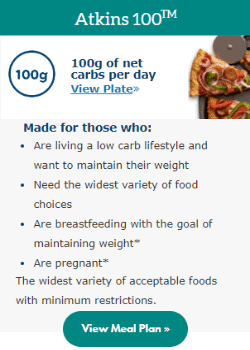
Usually, it's the maintenance plan for people who have already reach their ideal weight.
But in general, it's designed for the following categories [6]:
- people who want to try low carb diet or live a low-carb lifestyle
- those who want to maintain their weight
- pregnant and breastfeeding women with the goal of maintaining weight
- not pre-diabetic or diabetic people
- women with 35 inches waist size or less
- men with 40 inches or less
Basically – it requires a total of 100 grams of net carbs per day.
Just like the previous plans, it also suggests the distribution of carbs (100 grams) throughout the day:
- 3 x 25 grams (3 meals/day)
- 2 x 10 to 15 grams (2 snacks/day)
- the sources of carbs should come from foods mentioned in the Atkins 20®
Now, this type of plan is for people who want to maintain a fat-burning metabolism.
So it's for those who are looking after their weight (not gain or lose any).
The diet states that 100 grams of carbs daily is an acceptable level to help prevent weight gain.
Well – that only applies to people who are healthy and don't have sensitive carbs intolerance.
But if you're overweight, you need around 50 grams or less carb intake.
In this situation, this Atkins Diet plan is not suitable for you and you might want to check the other plans.
Conclusion
To summarize, all plans offered by the Atkins Diet have the same way of increasing weight loss:
- promote ketosis, which converts stored fats into energy (Atkins 20® and Atkins 40®)
- maintain fat-burning metabolism of the body (Atkins 100™)
The only difference is that each plan depends on a person's goal and current health state.
You can also start with the strictest plan first and then maintain your weight with the less strict ones.
Overall, this diet is not about removing carbs completely.
It's more about controlling your consumption of carbohydrates.
Atkins Diet's Top Risks & Side Effects
As I already mentioned, the Atkins Diet suggests restrictions on carbohydrate intake.
This means you fill focus on consuming the following foods [7]:
- proteins – meats (white or red), eggs, fish and seafood
- fats – avocadoes, full-fat dairy products and healthy oils (coconut, avocado and olive)
However – following this regimen is not free from drawbacks, just like other diets.
So even though it can effectively promote weight loss, it also comes with health risks.
If you're curious, here are the possible side effects of Atkins Diet:
- heart disease [8]
- kidney damage
- neuropathy [9]
- nutrient deficiencies
- increases LDL cholesterol levels [10]
- constipation or bloating
- risk of worsening diabetes
- weakness or fatigue
Now – the main culprits are high protein and saturated fat intake.
Also, this diet can lead to a lack of fiber in the long run.
Honestly – there are healthier ways to lose weight.
It's much better to follow a balanced diet, in order to ensure that you're getting all the nutrients your body needs.
Atkins Diet's Pros
Again – the Atkins Diet has a lot of claimed benefits.
So we can't deny the fact that it has some advantages too [11]:
- Quick weight loss
- Controlled appetite/hunger
- Improved cholesterol levels
- Regulated blood sugar
- Boosted energy levels
- Lowered carbs-related inflammation
As I mentioned, the Atkins Diet has several plans that target some aspects related to weight loss.
So it's truly one of the pros of this dietary approach, since you will be limiting carbohydrates.
Well – we all know that too many carbs can lead to weight gain.
Also, they can mess up your blood sugar levels, which can increase the risk of diabetes.
With that, it's helpful to cut them off – while still sticking to a balanced diet.
It's also better to exercise and a healthy lifestyle.
Overall – the major advantage of the Atkins Diet is that it can support weight loss.
Atkins Diet's Cons
As discussed above, the Atkins Diet can help with weight loss.
However – the way it works can cause several health issues:
- Short-term fatigue [12]
- Kidney stones
- Nutrient deficiencies
- Heart disease [13]
- Difficulties in maintaining the diet
- Social isolation and memory issues
The main culprit for the issues above is the high protein and fat intake.
Again – eating protein and healthy fats in a balanced diet is the ideal way.
But consuming them more than the other nutrient-dense food groups can be risky.
So if your main goal is to lose weight, there are safer alternatives you can use.
Final Conclusion
Overall – the Atkins Diet is a low-carbohydrate diet that promotes weight loss.
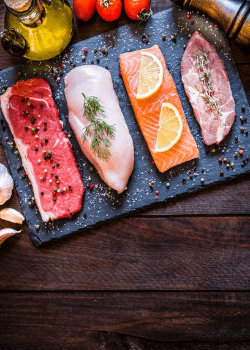
- Induction
- On-going weight loss
- Pre-maintenance
- Maintenance
Now – there are different types of plans depending on your goals.
They are called Atkins 20®, Atkins 40® and Atkins 100™.
The only difference between them is the number of carbs you need to include in your daily meals.
Also – the Atkins Diet claims to have a lot of benefits for overall health.
Its main promise is to help people lose weight and maintain their normal weight.
However – it's not free from causing side effects.
Again, the imbalanced consumption of protein, fats and carbohydrates can be risky for health (especially the heart).
So even if you could notice a fast weight loss, you might not like the potential long-term issues.
With that, it's still better to maintain a more sustainable and balanced diet combined with consistent exercise.
But you can still try the Atkins Diet at your own risk.
1 – https://www.atkins.com/-our-mission/
2 – https://au.atkins.com/why-atkins/-the-phases/
3 – https://www.ncbi.nlm.nih.gov/-books/-NBK499830/
4 – https://www.atkins.com/-atkins-20/
5 – https://www.atkins.com/-atkins-40/
6 – https://www.atkins.com/-atkins-100/
7 – https://www.atkins.com/-low-carb-diet/
8 – https://www.ncbi.nlm.nih.gov/-pmc/articles/-PMC7480775/
9 – https://www.frontiersin.org/-articles/10.3389/-fnut.2021.702802/
10 – https://pubmed.ncbi.nlm.nih.gov/-31805451/
11 – https://www.atkins.com/-how-it-works/faqs/-atkins20-faq/
12 – https://www.ncbi.nlm.nih.gov/-pmc/articles/-PMC8752375/
13 – https://www.ncbi.nlm.nih.gov/-books/-NBK537084/


